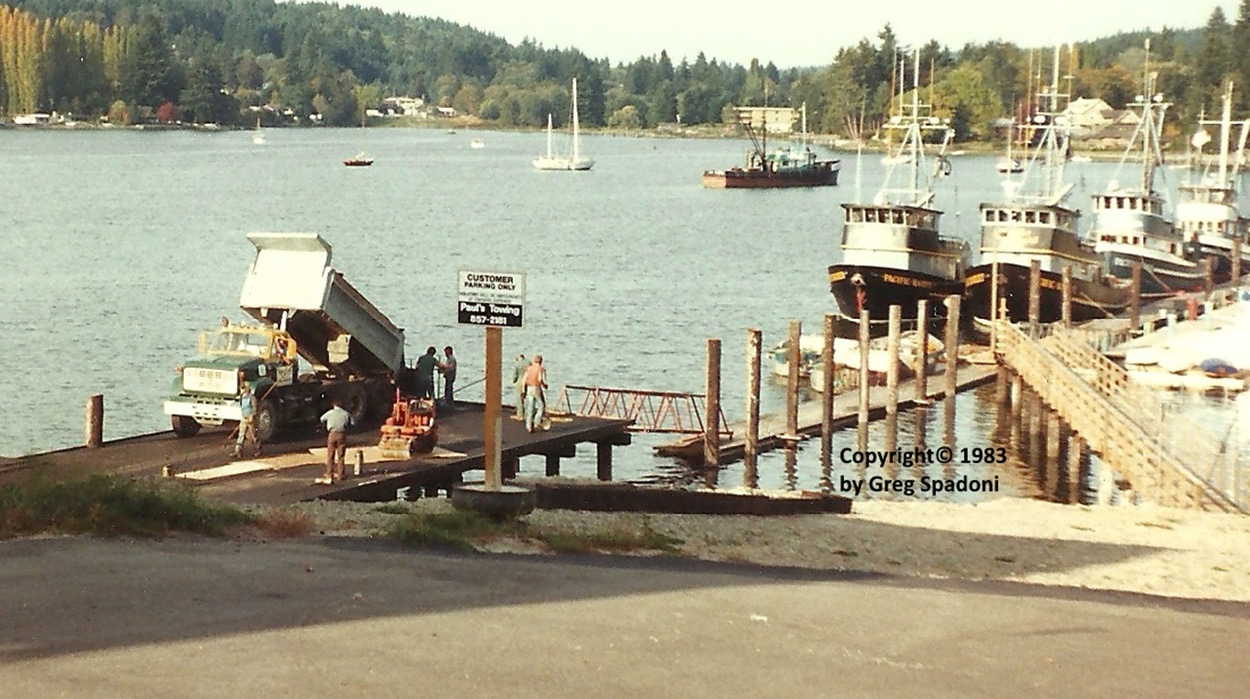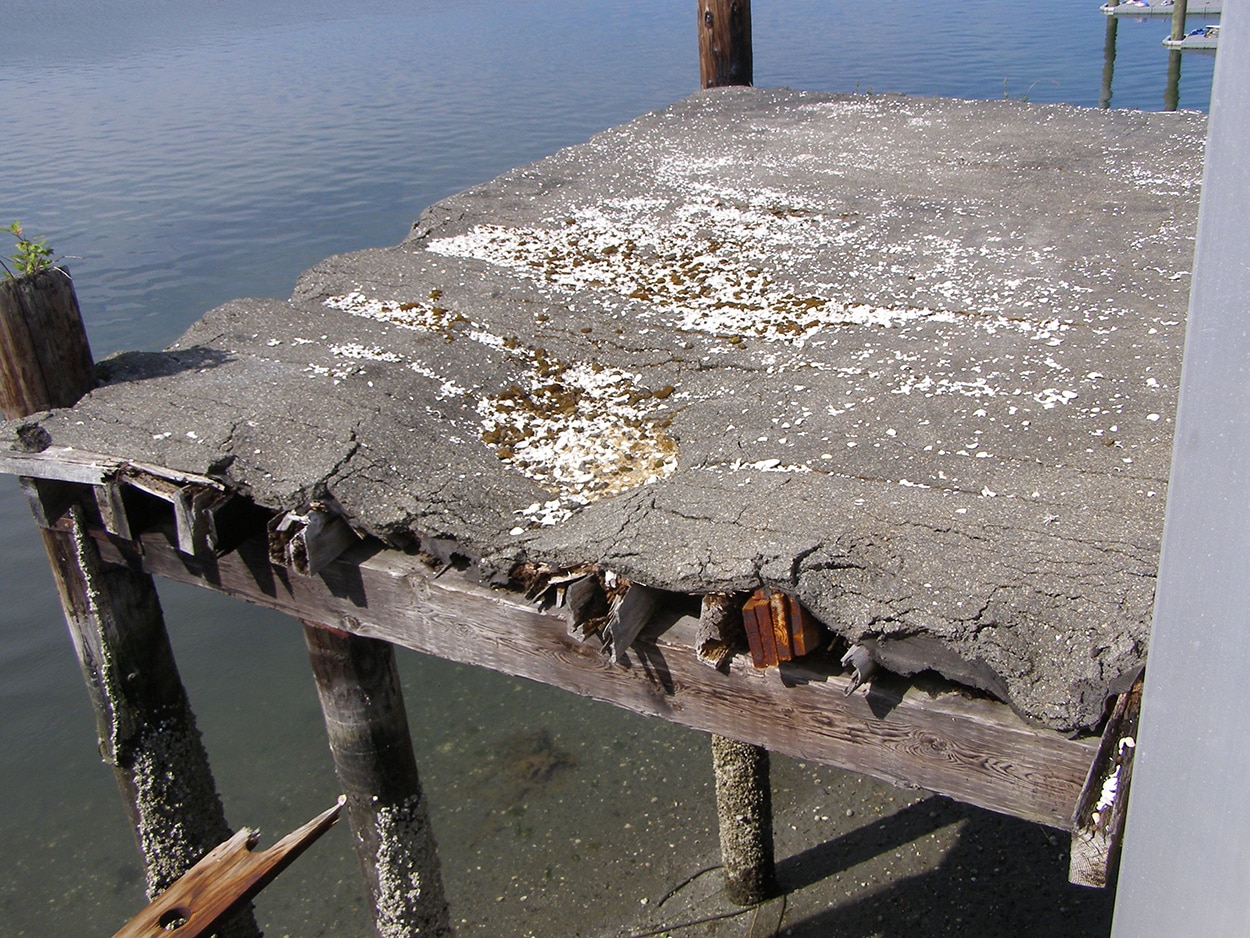Community
Gig Harbor Now and Then: A familiar name paved the old Jerkovich dock
The previous history questions in Gig Harbor Now and Then were several. They concerned part of the old Jerkovich dock, which is now incorporated into the city of Gig Harbor’s Ancich Waterfront Park. It is used today only by seagulls and crows for breaking clam shells.
Community Sponsor
Community stories are made possible in part by Peninsula Light Co, a proud sponsor of Gig Harbor Now.
The questions: Who paved the old dock? When was it paved? What are the names of two of the truck drivers who backed loaded dump trucks onto the wooden dock? How much did the loaded trucks weigh?
Spadoni Brothers
Answers: The old Jerkovich dock was paved in the early fall of 1983, by Spadoni Brothers, making this year the 40th anniversary. How fitting that is, for, as we all know, the traditional 40th anniversary gift is asphalt … or if it isn’t, maybe it should be.
As for two of the truck drivers, can you see me frantically waving my hand high over my head as I’m typing this? Yes, I was one of them. Another was Kevin Meyer.

It should surprise no one that it was Spadoni Brothers who paved the Jerkovich dock in 1983. From left to right, the legendary Stevie Fagerud (carrying a very long-handled asphalt rake), Kevin Meyer in the dump truck, Roger Spadoni standing in front of the roller, Larry Spadoni at the back of the truck, next to the paving box, Larry Ensor, Julius Spadoni, and Danny Green. Working on the other side of the truck, out of sight of the camera, were Steve Omage and Larry Crouse. The truck is sitting on the small portion of the dock that still remains today. Photo by Greg Spadoni.
The trucks were not fully loaded when they were backed out onto the wooden dock. While a standard load of asphalt for those trucks was 15 tons, we loaded only 10 or 12 tons for backing onto the wharf. Coupled with the empty weight of the trucks, each load weighed somewhere between 38,000 and 43,000 pounds.
Art in asphalt
On top of that, the paving box added another 4,000 to 8,000 pounds, depending on how much asphalt was in its hopper. Kevin remembers the timbered deck of the dock flexing under the weight of the trucks to the extent of inducing cracks into the first two lanes already paved. (They were sealed up with the final rolling.)

Even in its degraded state, the pavement on the old Jerkovich dock is a work of art. Photo by Greg Spadoni.
While the remnants of the old Jerkovich dock may look ratty and poor today, the remaining asphalt pavement, though broken and sagging, is actually a work of art.

Stevie Fagerud, now retired, was an artist with an asphalt rake. Photo by Greg Spadoni.
Spadoni Brothers’ longest-tenured raker, Steve Fagerud, was an artist. He was the best lute man any of us ever worked with, and we relied on him to put the finishing touches on even the most difficult jobs. The Jerkovich dock was not a difficult job, but the fact that Stevie Fagerud polished it to perfection makes it special. It is one of his earliest works. Removing it entirely would be an act of vandalism.
Next question
Remaining on the topic of Ancich Waterfront Park, we now go back nearly a hundred years before the paving of the Jerkovich dock, to the early days of the Millville plat. The new questions are:
- Who owned the first net shed on the site of today’s Ancich Waterfront Park?
- When was that first net shed built?
Hint: it wasn’t Ancich, and it wasn’t in the 1920s.
Another hint: the builder of the first net shed on the current site of Ancich Waterfront Park was the owner of the property previous to Ancich.
While we’re on the subject, let’s throw in a third question: What happened to the owner of the first net shed at the current site of Ancich waterfront Park?
And what’s a third question without a fourth? What became of the first net shed on the site of Ancich Waterfront Park?
Don’t believe everything you read
It would be pretty simple to look up the history of the park on the City of Gig Harbor’s website, but you won’t find the answers there. Like a lot of the written history of Gig Harbor, the city’s information was as good as could be found at the time it was compiled. But more accurate, more detailed, and more interesting information has been discovered in the years since.
Speaking from first-hand experience, it’s not so easy to get the city to update its historical information. Pretty much impossible, actually. But even though the city won’t, Gig Harbor Now and Then will.
Having given the hint that it was the owner of the land previous to Ancich who built the first net shed there, be aware that despite the city of Gig Harbor’s statement on its park history webpage that Peter Ancich bought the property from John Novak, he did not.
And since we’ve already stated that the first net shed on the property was constructed by the owner previous to Peter Ancich, the statement on the city’s park history page that says the property “includes the original and historic netshed” is also in error. It’s original to the Peter Ancich family maybe, but certainly not to that piece of property. In fact, there were two net sheds on the Ancich Waterfront Park property long before Peter Ancich ever built one.
While we’re at it, concerning the city’s statement, “As early as 1910, Gig Harbor’s first net sheds began appearing along the waterfront,” we’re going to — if you’ll pardon the expression — blow that out of the water too. Ancich Waterfront Park has a much deeper history than the city of Gig Harbor is aware of. Or even cares to know, apparently.
To recap this week’s multiple questions of local history:
- Who owned the first net shed on the site of today’s Ancich Waterfront Park?
- When was that net shed built?
- What happened to the owner of that net shed?
- What became of that first net shed?
Because all four questions this week concern a commercial fisherman’s net shed, we’ll ask one more related question, but provide the answer in the sentence that follows, just to give some historical perspective to the term “net shed.”
What’s in a name?
Bonus question: What did the early Gig Harbor commercial fishermen call their net sheds?
Answer: wharves. The term “net shed” is a 20th century invention. None of the early Gig Harbor fishermen used it. They kept their fishing gear on a wharf. Usually (but not always) inside a shed on a wharf, but the shed rarely got individual recognition.
Nick Castelan, who owned the easternmost of the three lots that now make up Ancich Waterfront Park, did once on record refer to his net shed as a “net house” in the 1910s, but still called his dock a wharf. And it stood on the current park property many years before Peter Ancich bought the two lots next door.
When, exactly, “net shed” replaced “wharf” in the local vocabulary isn’t known, although it definitely didn’t happen before 1915. More than likely, it was a gradual, generational shift.
Until the answers are revealed here on Oct. 9, you’re invited to visit the Gig Harbor Now Facebook page and post your guesses and other thoughts about today’s questions, and read what others have to say about them.
Comments on the answers given today are also welcomed. And if anyone reading this column knows Stevie Fagerud, there will be comments, whether they’re posted on Facebook or not. They could fill a good, thick volume.
Greg Spadoni of Olalla has had more access to local history than most life-long residents. During 25 years in road construction working for the Spadoni Brothers, his first cousins, twice removed, he traveled to every corner of the Gig Harbor and Key Peninsulas, taking note of many abandoned buildings, overgrown farms, and roads that no longer had a destination. Through his current association with the Harbor History Museum in Gig Harbor as the unofficial Chief (and only) Assistant to Linda McCowen, the Museum’s primary photo archive volunteer, he regularly studies the area’s largest collection of visual history. Combined with the print history available at the Museum and online, he has uncovered countless stories of long-forgotten local people and events.

